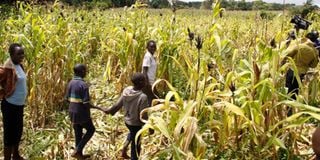Know the two major maize crop diseases

A maize farm attacked by head smut disease in Iten, Elgeyo/Marakwet County in 2016. Growing resistant hybrid seeds helps control the disease.
Last week’s article looked at farm records that Farmer Moses is keeping. Today, we shall look at diseases that the farmer is likely to encounter during the production season.
Diseases reduce crop yields because the plant is unable to produce at its full potential. They also reduce the quality of the product, which eventually leads to low market prices.
Key diseases include maize smut and maize lethal necrosis that affect the crop. Smut is a fungal disease caused by Ustilago spp. fungi. It affects crops such as maize, wheat, sugar cane and sorghum.
Smut can affect any above-ground plant part, and symptoms are localised to the site of infection. The fungus attacks all parts of the plant, that is, leaves, stalks, tassels and ears, even below the soil surface.
The first indicators are white galls that rupture later to produce dark spores that can infect neighbouring maize plants.
The tassels, shoots and midribs of leaves are frequent sites for the galls, which can grow up to 15cm in diameter. Galls on leaves are usually small and do not burst out.
Crop debris
The fungus overwinters on crop debris or in the soil and can survive for several years. The fungus usually enters the plant through wounds. Applying phosphorous fertiliser reduces infection while using too much nitrogen fertiliser raises the incidence of disease. The disease reduces corn yields and can cause economic losses.
Growing resistant corn hybrids is the only strategy for controlling common smut that is totally effective, despite the fact that several practices may be suggested. Using certified seeds also helps for farmers. Field hygiene should be practised to prevent harbouring the disease.
Crop rotation is essential as the spores overwinter in the soil. Crop rotation is mainly done with beans, cowpeas, and peas. To stop the disease from spreading, the affected plants can also be uprooted and properly disposed of.
Maize lethal necrosis, on the other hand, is a viral disease that ravages the crop. The signs include mild to severe leaf mottling, dwarfing and premature aging.
Chlorotic mottling
The chlorotic mottling on the leaves often begins at the base of the young leaves in the whorl and extends upward toward the leaf tips.
A "dead heart" results from the immature leaves in the whorl dying just before they expand. On the stem, lesions occasionally related to unfolded leaves can be seen. Finally, there are tassels devoid of pollen and poor grain filing.
Using certified seeds, maintaining field hygiene, eliminating volunteer crops on the farm, managing hosts and vectors, and making sure crop rotation is done particularly with non-cereal crops, helps in controlling the disease.
Farmer Moses will be on the lookout to identify early the diseases on his maize crop just in case of any infestation. On the other hand, he is still carrying out management practices such as watering and top-dressing. The second weeding has already been done.
In our next article, we shall look at scouting in maize production.





